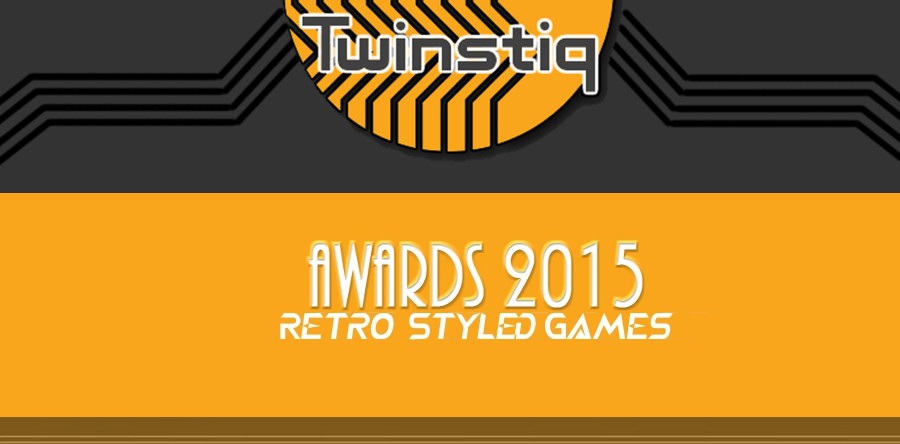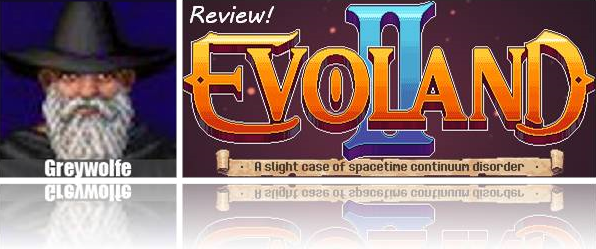Well.
It’s that time of year again.
Time to dash through four games on my giant backlog.
This year’s going to work a LITTLE differently, though.
I’m going to be STREAMING most of what I’m playing.
So let’s talk about that.
Read moreWell.
It’s that time of year again.
Time to dash through four games on my giant backlog.
This year’s going to work a LITTLE differently, though.
I’m going to be STREAMING most of what I’m playing.
So let’s talk about that.
Read more
Welcome to my retrospective for 2015 in which we talk a little about those games that invited you to think of gaming's past through the lens of what's happening right now. This list covers games that - somehow - evoked games of yesteryear, whether in their visuals or in their gameplay styles.
2015 was a pretty good year for this style of thing - I didn't play all of the games that had retro-styled conceits, [like Freedom Planet or some of the bigger RPG releases] but the games I played that used those sorts of ideas were all [more-or-less] fun.
NB! The text links in this article will open in a new page and will take you to review pages on my personal blog. Read more

My comfort zone when it comes to video games extends to slow games. I like adventure games. I like turn based strategy games [assuming there aren't a billion units]. I like turn based role playing games [assuming there isn't a stupid ton of micromanagement]. So, platformers are generally right out. The speed of a platformer, coupled with the number of enemies and the level of sheer frustration those games can engender just make them not worth my while.
But I've been trying. I most recently beat Evoland 2, a game that takes some inspiration from platformers of the past. I also beat Shovel Knight, again, earlier this year, because I love that game a great deal.
Both these games are great, but they're modern and have modern gamers in mind. Evoland - thoughtfully - saves your progress every time you change scenes. Shovel Knight has a clever, player-directed difficulty setting where you can either break your checkpoints or you can leave them intact, allowing you to make the game incredibly difficult, or just "somewhat challenging."
Banjo-Kazooie, however, comes from a different time. A time when men were men, squirrels could get their own game and you could still get away with making a cutesy, animal-based platformer.
Banjo-Kazooie is this last, a cute, animal-based platformer that doesn't really take itself seriously at all. The plot is pretty simple: Bad witch discovers she's not the nicest looking witch in all the world. A bear by the name of Tooty is. She decides this simply will not do, kidnaps the bear with the intention of swapping bodies and gets caught in the act, red-handed by a mole named Bottles. Bottles yells for Banjo to help his sister, which, basically starts the adventure.
The creepy nature of the plot aside, Banjo-Kazooie is a blast. You start at Banjo's house where Bottles teaches you a couple of moves that you can use to jump, stomp and run through each ensuing level. For the first few worlds, your move set will slowly broaden until you can fly, bomb creatures from the air and run extra fast with the help of a pair of running shoes.

Each level is a complete little world, with it's own particular perils and theme. In one world, you might be in a winter wonderland, while in another, you may be traversing a scary mansion. No two worlds are ever quite alike. Each has its own [fantastic] musical theme, little character designs that show just enough personality to be memorable [but, given the brief nature of your visits to each, don't get fleshed out overmuch] while never getting in the way of game play or bogging the player down with superfluous fluff.
This particular game comes from an age that incentivized exploration through collectibles. In Banjo-Kazooie, the main "currency" of the game is the musical note. You can pick up 900 of these and each note that you pick up brings you closer to opening sections of Gruntilda's [the witch] lair. At the beginning, you simply need fifty notes to progress, but as the game slowly winds up the difficulty crank, so it expects you to rise to the challenge of collecting ever more notes.
To unlock future worlds, you need puzzle pieces that complete picture frames throughout the lair. Again, starts off simple - you only require one of these to get into Mumbo's Mountain, but by the time the game winds down, you're going to make sure you're scouring levels for as many as you can get. These are - in the game's parlance - Jiggies.
Jiggies are earned through doing a collection of little "quests" throughout the level you're in and these are great. It's a very rewarding way to entice the player through the game. Some are fairly "standard." There's a Jiggy for collecting a "collection" of Jinjo's - little, bird-like creatures that have been scattered throughout the levels by Gruntilda, while others are more esoteric and need far more work. In one of the very last levels, for example, your patience with a young bird [that you hatch, yourself - and then later feed, too] is rewarded when, at last, the bird takes to the skies and reveals the Jiggy it was holding onto for you.
There are other collectibles: extra lives, honeycomb pieces [that extend your life bar] and Mumbo tokens [which allow you to visit the local shaman, Mumbo and be transformed into something native to the world you're in. In one world you might be an ant and in another, you might be an incredibly adorable walrus.] all of which you'll seek out, but the main game requires that you simply collect notes and Jiggies.

And this seeking out is the most fantastic thing about the game. Modern games will hold you by the hand and guide you, step by step through what you need to be doing next. Shovel Knight had the over world. Evoland 2 - while incredibly open in it's second act - still has a structure you can follow. Banjo? If you're smart and wily, you can sequence break - going into worlds that you should only visit further along in the adventure. Likewise, each level is wide open. You can start at any point [for the most part] and collect any Jiggy you choose. [This is almost always true. A couple of worlds force prerequisites on you - Clanker's Cavern has an entire second half that can only be done by doing a very specific Jiggy-related task.]

One of Banjo-Kazooie's greatest assets is this variety. You never quite know what you're going to run into while you're playing and this makes it easy to want to play. If there's one thing modern gaming has entirely lost, it's the element of "what's around the next corner" and this particular game has that down to a fine art. Wozza the Walrus won't deal with me if I'm a bear, but how about when I'm a walrus, too? There's this very weird camel guy in Gobi's valley that says all this funny stuff, I wonder if I can get him to move? All these little things add up to make Banjo-Kazooie a joy to play.
But it is not without its faults.
One early move you learn is a maneuver that allows you to toss eggs, but it's never as accurate as you'd like it to be, because 3d gaming was in its infancy and trying to aim your "missiles" so that they did what you wanted could be quite daunting. This is - to a lesser extent - a problem with every move in the game. 3D wasn't a perfected art at this point, so judging distances - especially when you're high up in a level and the prospect of falling is a clear and present danger - could be tricky. One of my single biggest gripes with the control of Banjo-Kazooie was that they didn't just come to a complete stop. Often, if you're running in a direction and you take your hands off the controller, there's a little gap between your action and the action on screen. Essentially, the bear and bird pair will skid to a halt a couple of steps further than you meant for them to be. This can create a weird kind of terrible tension where you absolutely need to stop dead, and sometimes, the game will keep moving you, plummeting you to your doom.
In the same vein, the forced swimming is atrocious. You get "used to it" by the end of the game, but it is difficult to control, has a tendency to make you overshoot your actual goal and drowning is a thing that can really happen.
And when you die...
...Well, I mentioned that this was an old game with an older design paradigm, so when you do kick the bucket, your notes that you collected get revoked. You're forced to re-play that section of the game again to re-acquire all the notes you just lost so that you can beat your "note score" for that world. This can be a frustration at the end-game where the levels get increasingly more difficult and require particular dexterity on your part. [Engine room in Rusty Bucket Bay, I'm looking at you!]
Besides, at least this frustration has been dealt with in the XBox re-issue of the game.[that you can currently snag through the Rare Replay compilation.]
This Xbox version introduces it's own set of frustrations - Motzhand's organ plays exactly the same note regardless of which key you hit while you're working with that particular puzzle. All of the Nintendo branding and shout-outs are gone [this is understandable, but sad] and that special kind of tension where you lose all your notes when you die is gone. [This can swing both ways. On the one hand, the challenge can be interesting. On the other, it can also be particularly frustrating.]
What do I think of Banjo-Kazooie? I think it's absolutely worth experiencing. The current re-release does some things rather differently, but if you've never played it, this would be the place to start. Of course, if you want the original experience, you should attempt to find it for the Nintendo 64.
This is easily, behind The Dig, one of my favourite games this year.
This is a cross-post from Greywolfe's Blog.
Honeycomb image courtesy of Pixabay

If there's one problem with most of the modern games I play, it's that they don't have an inviting world and setting. A kind of place where I can get lost for several hours and surface for air having taken in a chunk of lore and game play. Read more

I love indie games. So much so, in fact, that I've basically given up on AAA development. AAA development - to me, at least, seems like an endless cesspool of "generic brown shooter 56," or "Watch The Crew Dogs Cry Far As The Creed of Assassin's" takes over. Or to some degree or other, they're plagued with silly launch day fiascos that involve you paying extra money to get stuff that's already on the disk. Even if you somehow dodge all those bullets, you have to contend with pre-order exclusives, Day 1 "Downloadable content" and my absolute favourite, "we're patching the game on day 1, because we didn't actually test properly, so now we have to fix all these errors at launch." [which, of course, doesn't work for the most part, cf: the fiasco that was Batman: Arkham Knight, where that game just didn't work at launch and then continued to just not work even after patching.]
So, I'll take indies any day over AAA games. The experiences are shorter, more focused, often reasonably tested [within the limits/budgets of the small team, of course] and often, they're just more fun to play.
I'm currently about half way through Evoland 2, a game I've been waiting for for several years, now. It does absolutely everything better than the first game and is proof that indie devs can learn from their previous offerings.
The problem is, indie devs still need to learn one crucial skill and that's communication. Read more